This past Father’s Day, my son Nate suggested we sail across Puget Sound to the village of Indianola for our annual outing. We had sailed there on a summer day 19 years ago when he was 14, and apparently he remembered that outing as fondly as I did. His sister Alison, then 11, was also with us, along with her friend Sarah. The two of them spent much of the time lying bellies down on the foredeck singing Girl Scout camp songs. There was a reaching breeze out of the north, enough to move my Caledonia yawl ALISON at a good clip while only rippling the Puget Sound waters. We made the 7-mile crossing under a broad clear sky in good time and made our landfall on Indianola’s broad sand flats, which stretched 250 yards out from the silvered driftwood above the high tide line to the retreat of the water at a minus tide. We left the boat at the water’s edge with the anchor set as far as the rode would reach shoreward. As we walked ashore, Ali and Sarah tiptoed through shallow tidepools, sending 1′-long flounders fluttering away leaving gray contrail clouds of sand behind them. Indianola’s general store was just above the beach. We went straight to the freezer for ice cream. We bought ice-cream sandwiches and Drumsticks, those vanilla-ice-cream sugar cones, topped with chocolate and crushed peanuts.
The forecast for this year’s Father’s Day outing with Nate was for weather less pleasant than we’d had for that sail to Indianola in 2004. A south wind to 20 knots and waves to 2′ with thundershowers predicted for the afternoon made it unwise for us to cross the Sound. We hadn’t been to the Duwamish River in at least a decade, and, while it offered well protected waters on the South end of downtown Seattle, it flowed through the city’s industrial district and was flanked for miles by docks and windowless warehouses. We decided to give the river a try and pulled ALISON out of the back yard and headed to the launch ramp on Alki Point, a little over a mile to the northwest of the mouth of the Duwamish.
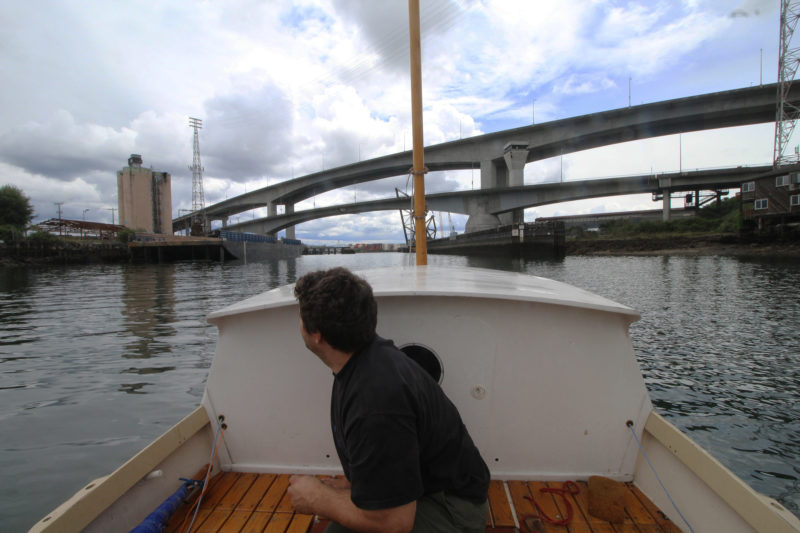
We set out under a cloudy sky, but patches of blue had opened to the south and the air was warm. We motored from the ramp across Elliott Bay and into the mouth of the Duwamish River. We passed one of the three Port of Seattle container terminals where four spidery cranes were perched side by side on a ¼-mile long dock. Beyond them were two highway bridges and an open bascule railroad bridge.

South of the bridges we approached the intertidal sandspit on the downstream end of Kellogg Island. Nate scrambled over the cabin top and watched the shoaling water from the foredeck and at his command, I cut the motor. ALISON quietly hissed to a stop on the sand. We ate lunch—deli sandwiches—standing in shin-deep water alongside the boat, then walked about 100 yards toward the island and its brush-crowned high ground. On a downhill slope in the middle of the spit I slipped where the sand turned to mud but managed to stay on my feet. Rather than struggle with the mud there, we turned around and walked back to the boat.
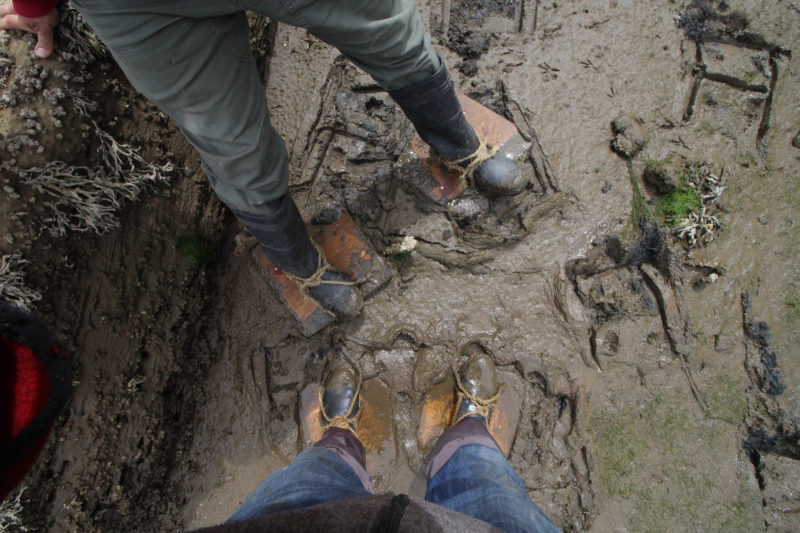
I rowed ALISON along the river bend that arcs around Kellogg Island’s west side. The bend is the only one remaining after 15 others were bypassed in 1916 by a 3-1/2-mile dredged channel known now as the Duwamish Waterway. In 2017, I’d stopped along the west bank to test the pattens I’d made and written about for the October issue.
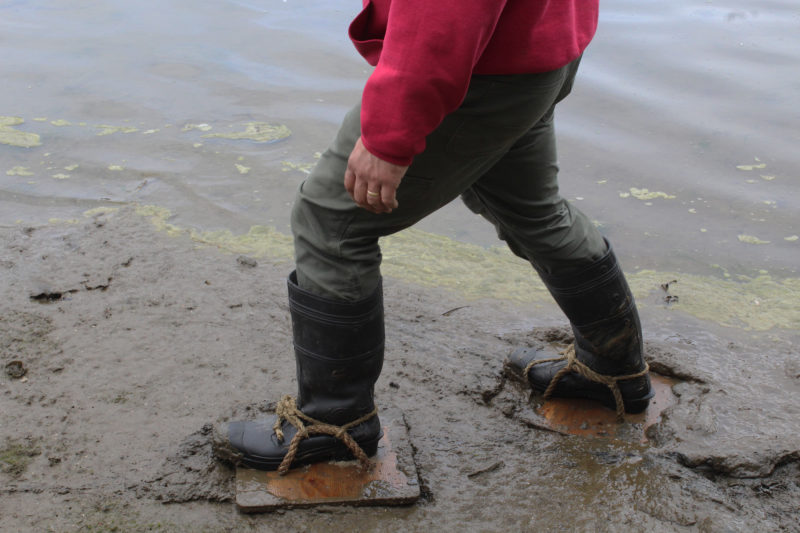
We landed and Nate and I strapped pattens on to walk along the tide-exposed mudflats. The mud wasn’t deep, but it was very sticky. Like kids in new rubber boots looking for puddles we clomped around to walk on the deepest, stickiest mud we could find.
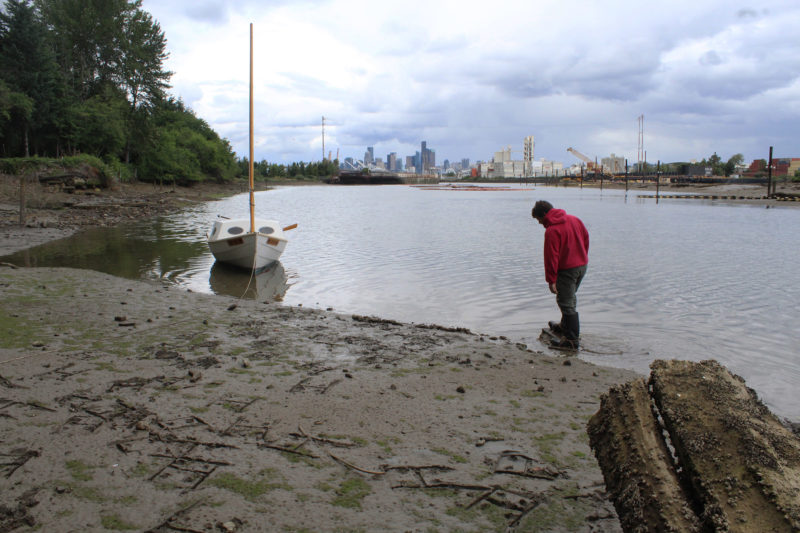
This ½-mile-long remnant of the river’s original course remains undeveloped. It had been home to the Duwamish First Nations people for thousands of years, but the only signs of habitation Nate and I saw were red bricks strewn everywhere we walked.
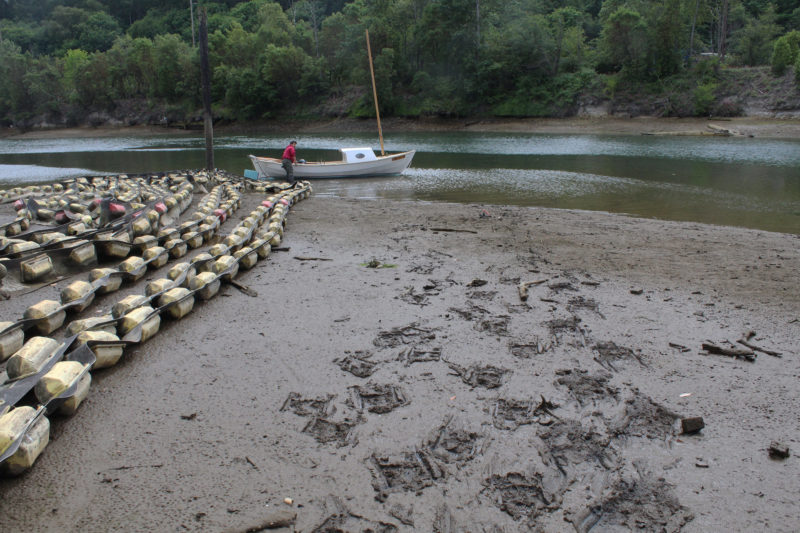
Before we arrived and left our H-shaped patten prints in the mud, the only tracks were those left by great blue herons. We returned to ALISON, and, still wearing the pattens, used the oars to paddle across the river back to Kellogg Island. A century ago, it was known as Muddy Island, and while the low tide had left the island surrounded by an undulating skirt of raw-umber mud, it wasn’t deep but it was slippery. We kept the pattens on for the grip the cleats on their bottoms provided and walked as far as we could around the south end of the island before backtracking to the boat.
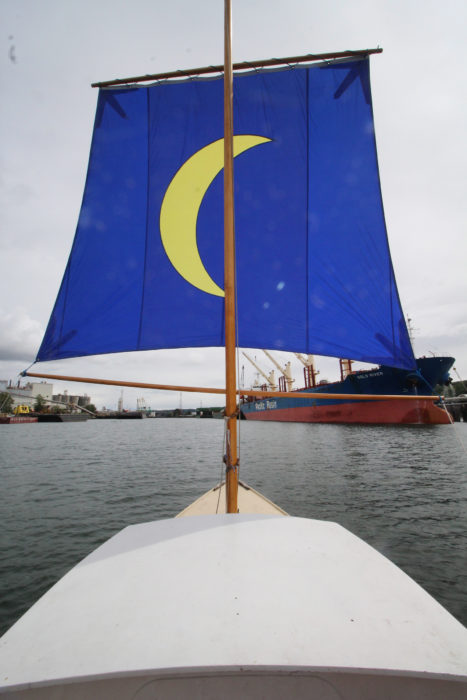
When we rowed out from Kellogg Island we saw that there was a northerly, upriver breeze on the Duwamish Waterway. We stowed the oars and raised the squaresail. This dredged channel has provided a place for ships and industry but the new enterprises that inhabited the banks created for them so abused the river that it became one of the most polluted rivers in the country and was declared a Superfund Site by the EPA in 2001; efforts to restore the river’s health are ongoing.
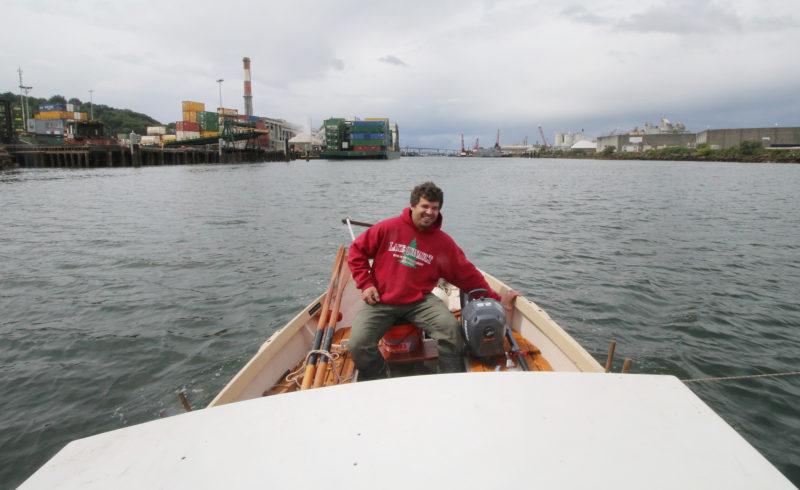
When the breeze began to fail us and even backed the squaresail a few times, I suggested we put the outboard, here alongside Nate, back in the well and motor upriver. He insisted we do without the noise and continue under sail, no matter how light the wind. Even in the lulls, we made progress upriver with the flood tide carrying us at almost 2 knots. We eventually had to drop the sail and the mast to pass under two roadway bridges 6 miles from the river mouth. We carried on another mile, came to a bend in the river that was shallow and rocky, and turned around.
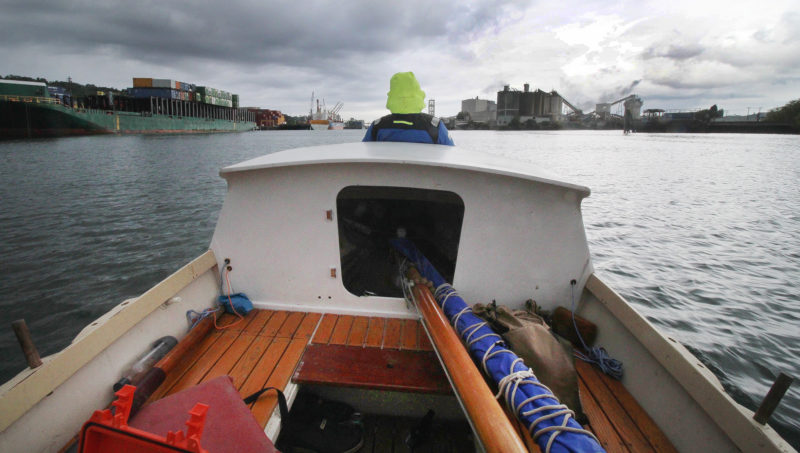
On the homebound stretch, against the wind and tide, the storm clouds we’d seen to the north had drifted over us bringing rain and a sudden drop in temperature. We bundled up in our raingear. Nate climbed over the cabin and tidied up the foredeck in anticipation of a rough crossing of Elliott Bay. When he returned to the cockpit, he stood in front of me looking over the bow. I watched rainwater dripping from his jacket onto the backs of his pantlegs and into the open tops of his boots. I was faring a bit better in my cagoule, but a seam I hadn’t sealed was seeping water on my shoulders.
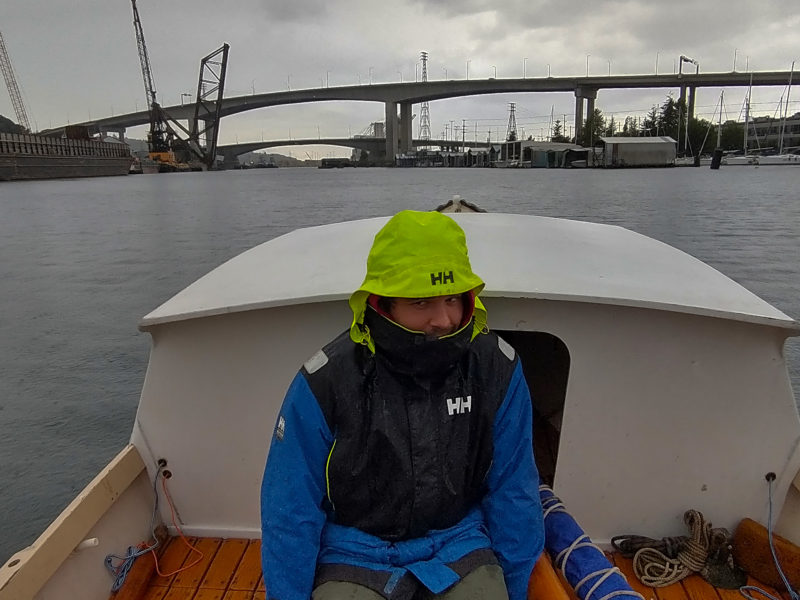
We were both getting cold as we approached the last mile of the river. ALISON can be operated from inside the cabin (visible on the port side of the cabin wall are the lines for a rudder yoke and the kill switch). I suggested we retreat to it, but Nate preferred the rain to the noise in the cabin. We toughed it out for the remaining 2-1/2 miles to the launch site.
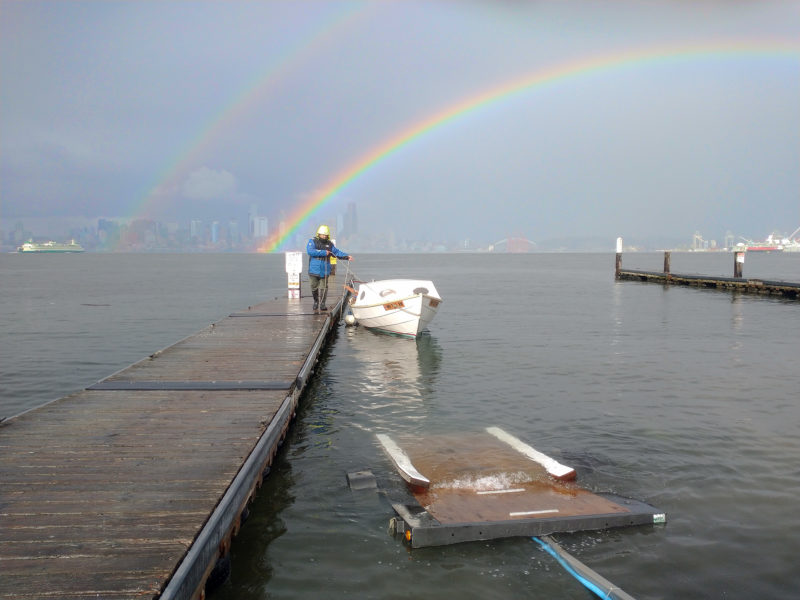
Nate and I were both thoroughly wet and chilled by the time we reached the ramp, but within minutes the sky to the west cleared and the rain stopped where we were. (It continued to fall on Seattle’s city center.) By the time ALISON was out of the water, we were both warmed up.
Our afternoon on the Duwamish was not at all like the crossing to Indianola 19 years earlier. Instead of a clear sky and warm sunlight we had ashy clouds and chilling rain. Instead of the broad unfettered expanse of Puget Sound, we had a polluted canal hemmed in by ships and cargo terminals. Instead of running barefoot on sand flats and through tide pools, we plodded in boots on slimy toxic mud. I expect that 19 years from now I will remember this time with Nate as fondly as I do our summer sail to Indianola. Sometimes what matters most is not where you are but who you’re with.![]()

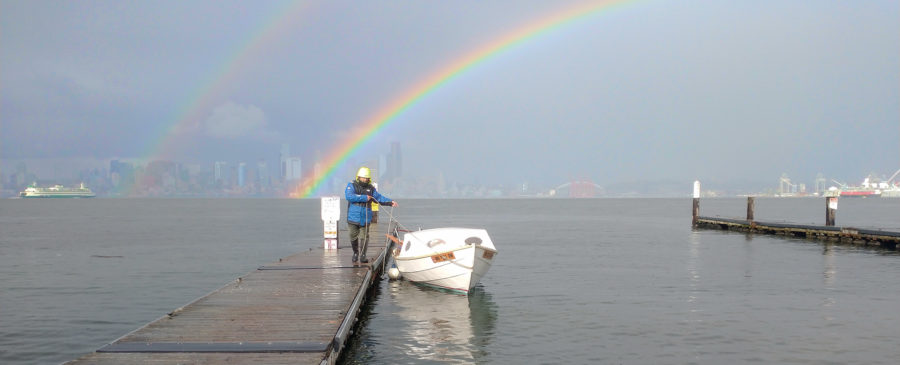


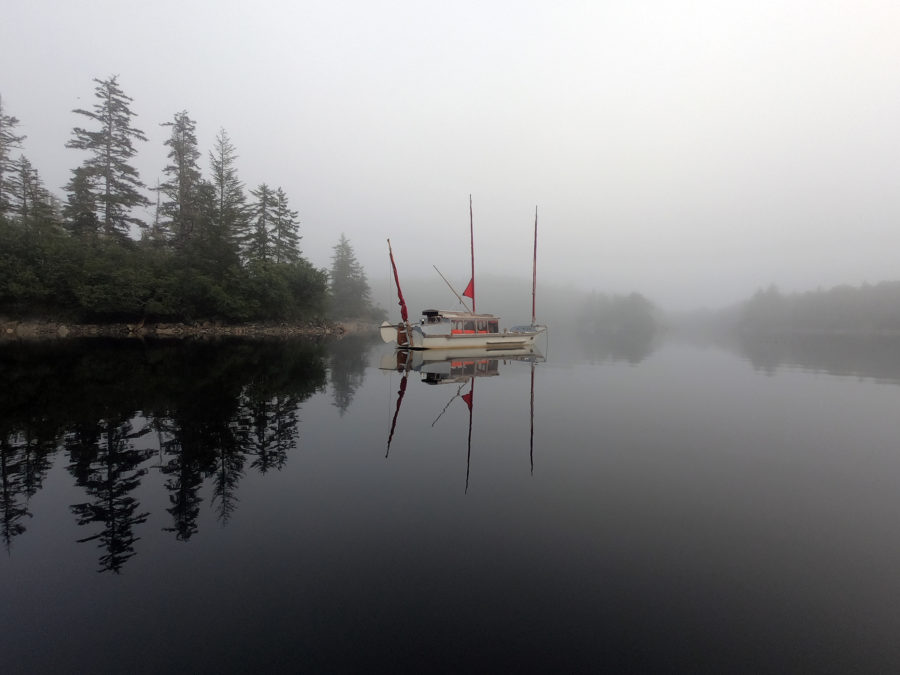
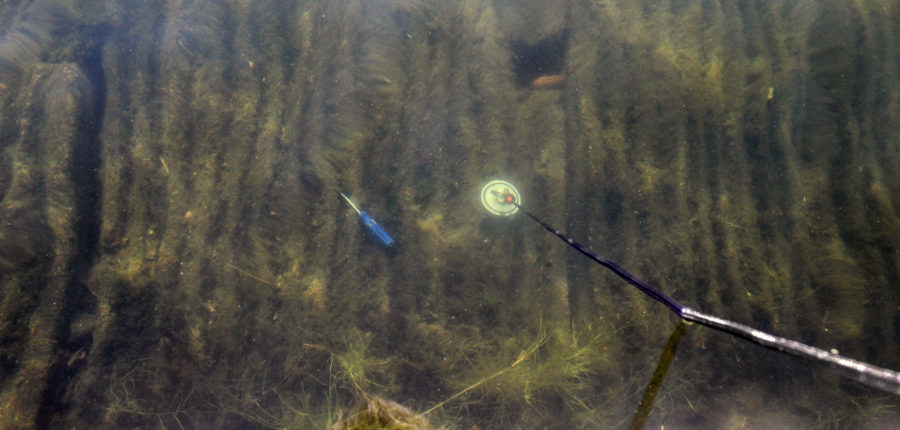
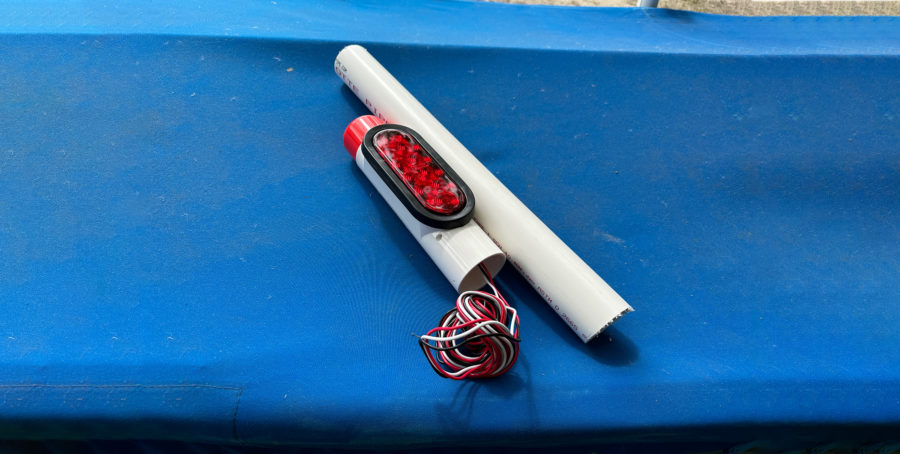
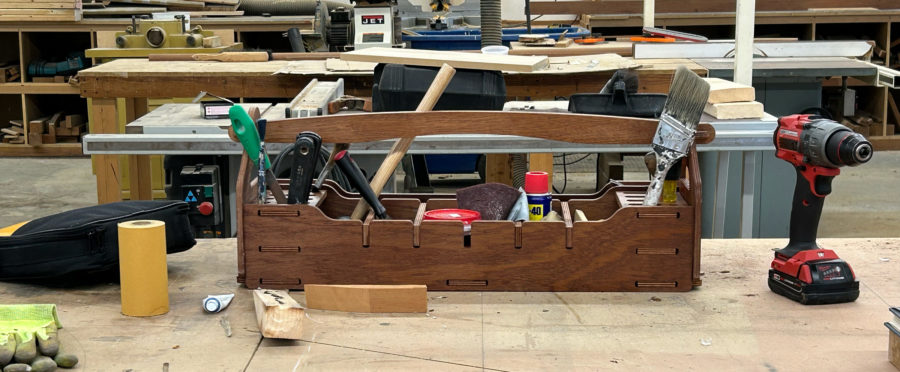
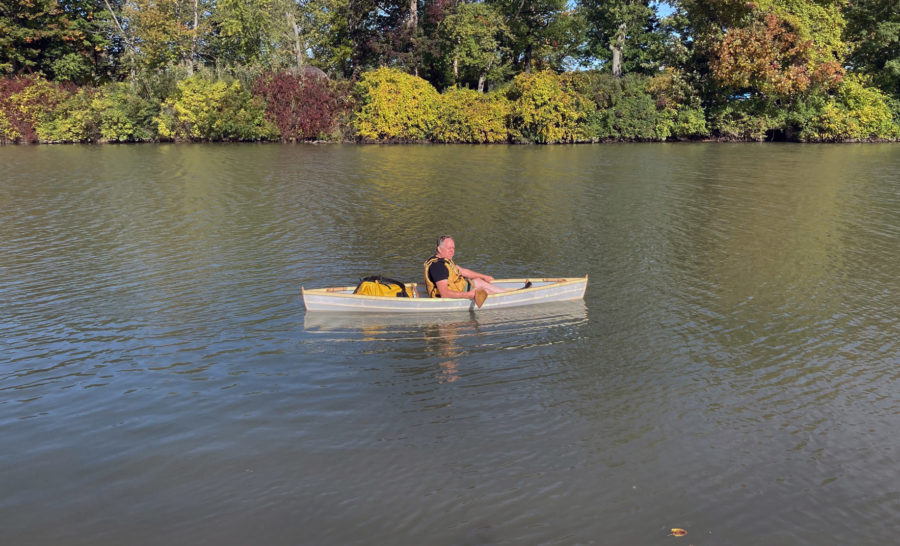
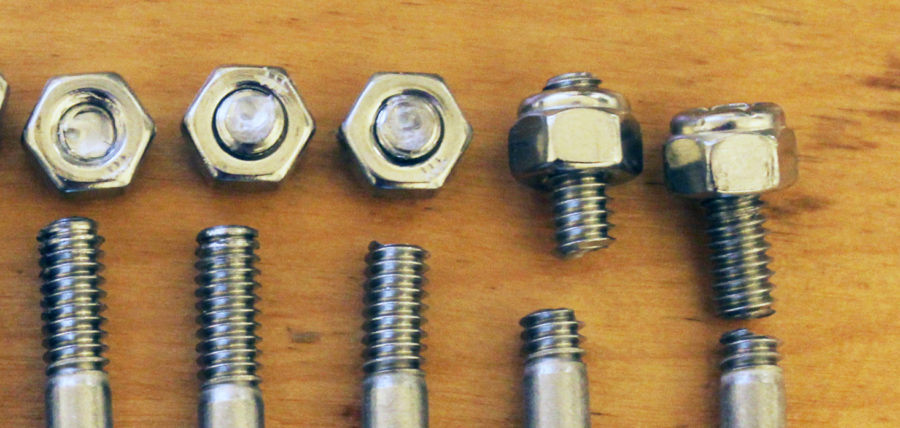

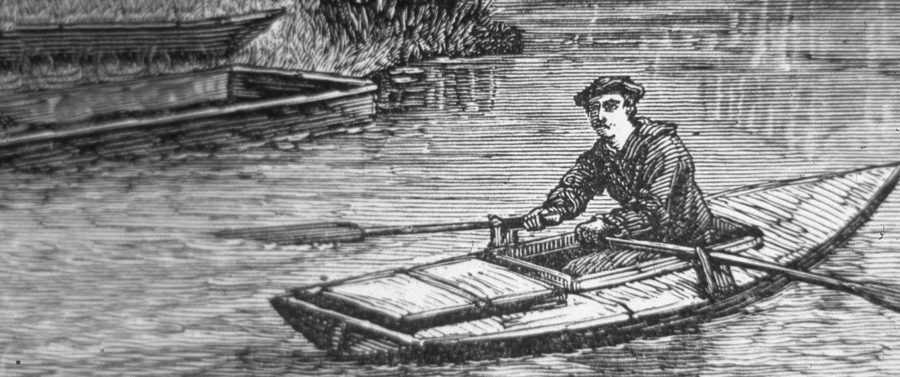
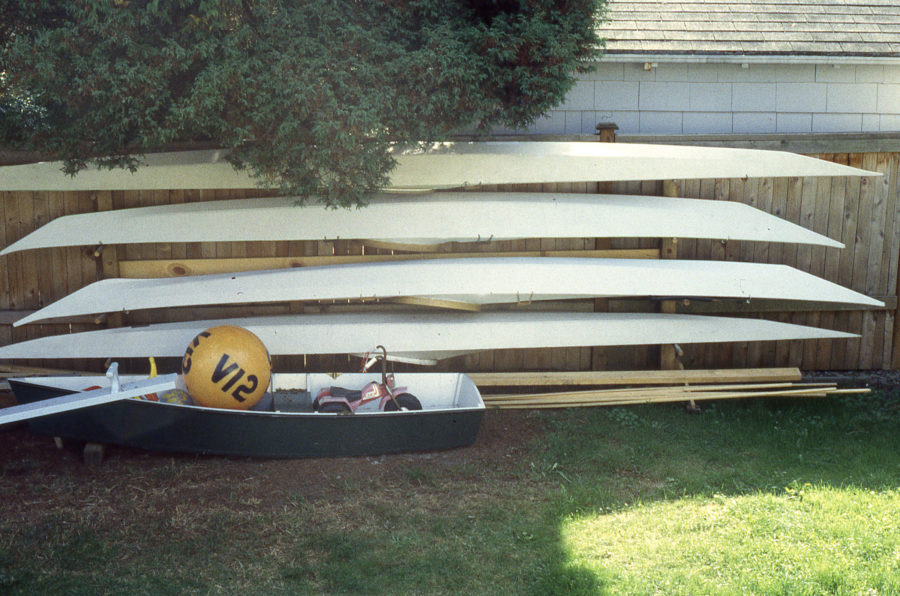
Great story, as ever. I kept wanting to see a picture of the interior of your custom cabin house!
You can get a few glimpses in my article “Gimme Shelter” and in the video posted in it.
Thank you for the link. I checked it out and enjoyed the video.
Chris, what are the rows of float-like connected objects to the left in the seventh picture? Are these booms for containing oily materials? Ken Dodds
Those are oil-spill containment booms. There are several of them parked around Kellogg Island. My guess is that they are kept there for quick access when there’s a need to surround a ship that has developed a fuel leak or suffered a spill.
Hi Chris,
Another great piece from you…and a new term for me: a “minus tide.”
I enquired of Admiral Google and found that this, with the tidal time lag of full moon, is exactly what I have this weekend here in the Bay of Islands, New Zealand.
I think, back in my native Cornwall, we called this event a “King Tide,” an exceptionally high or low tide.
The term King Tide is used to describe a spring tide that occurs when the moon is at is closest to Earth in its elliptical orbit. Perigean Spring Tide is a less eloquent term for the phenomenon. Here in Seattle, the day of this outing, June 18, Father’s Day, was a spring tide of minus 2.4’ at midday. July 4 was a King Tide of minus 4.0’ at midday.
An interesting thing about Small Boats is that its content probably won’t catch the eye of a reader of a slick Condé-Nast publication, Sailing, Yachting, and others. This is an attraction.
We often think that if we don’t spend a lot of money and time planning and arranging something, accompanied by a very serious—nay, joyless—attitude, it is no good for our enjoyment.
But, we can still enjoy a day out in an industrial backwater in a simple, inexpensive boat, or to like fiddling about with a makeshift gadget for some marine purpose, or to see what we can find in the water with a magnet, if we will only let ourselves. There is still the child-like curiosity and joy in doing accessible things that often elude us when we spend substantial amounts of money on “serious” pastimes. Maybe we have talked ourselves out of admitting to some childlike parts of ourselves.
Many of us shy away from making or modifying anything to use on our boats. Instead, we rely on finding a stainless-steel official “marine” whiz-bang in a boating catalog. In my lifetime we have become less familiar or confident with tools and our hands and often we believe everything must be done by a specialist. We have come to look down on people whose occupations involve working with their hands.
This is a change from people during my childhood in the ‘50s and ‘60s. A year or two ago, there was a tongue-in-cheek letter to the editor of Fine Woodworking suggesting the magazine’s name be changed to Fine Woodmachining. I wonder how this relates to the general focus on things digital. We have traded manual skills for digital ones, although the latter often have less to offer us. But you know all this.
I write this not to bash the mainstream, but to suggest that these topics are worth educating people about. Keep up the good fight.
Ken Dodds
You keep at it, Chris! Otherwise industry will think those channels are theirs to pollute as they please! The waters too, they yearn for someone to enjoy them, not only exploit them. Ripples of happiness spread from your boat and affected the environment beyond visible wake and patten prints.
Memorable! Well done, Chris, carrying on the fine, slightly countercultural tradition of messing about in boats, whatever boats you have, on whatever waters are at hand! I love this, and it is exactly the kind of thing that keeps me coming back here! Only one question, though. Which one of you is Mole, and which is Ratty? All the best!
Humble waters are not without their power to generate some fine times and lasting memories, Chris. Some years ago, we launched our Arctic Terns at Village Park (Terminal 105) along the Duwamish for a lazy day exploring the industrial landscape. We’d ignored tide tables and found ourselves on the north side of a Harbor Island rail bridge with (it seemed) barely 2′ water to bridge clearance. A northerly wind had pickup up in the Sound and I feared we’d need to counter-clockwise return with lee shore concerns. My wife noted that return passage under the bridge was possible if we stowed paddles, lay on our backs in the boats and hand-to-hand “walked” back under the bridge. A grand day.
Thanks for these occasional tales of small-craft adventures.
A good story of having fun in your boat. Well done. Simple fun often provides the best memories.